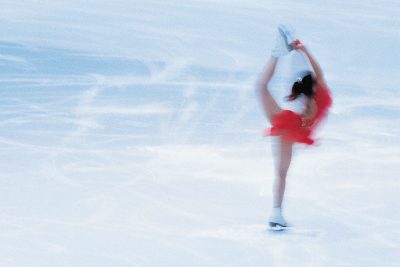
Editor’s Note: The following piece was originally published on UConn Today.
Behind the artistry of today’s Olympic figure skaters lies some serious science. A new book by UConn professor Jaci VanHeest will make the research underlying elite skaters’ training accessible for the first time to coaches and athletes everywhere.
“Every sport has its mythology, but the science is critical,” says VanHeest.
Figure skating is one of the oldest Olympic sports, but there’s not a lot written about the science of it. Coaches who want data-driven training techniques have very little information to go on. Jaci VanHeest, associate professor of educational psychology in the Neag School of Education with a joint appointment in kinesiology in the College of Agriculture, Health, and Natural Resources, specializes in the performance of elite athletes and is a member of the Medicine and Science committee for USA Figure Skating. She and her coauthor and former graduate student in exercise physiology, Jason Vescovi, now with Skate Canada, wrote The Handbook of Sports Medicine and Science, Figure Skatingto fill that gap.
“We can use technology not only to research elite athletes, but to help developing athletes attain their peak performance.”
— Jaci VanHeest, associate professor,
educational psychology
The book will be the first text on the market to provide in-depth coverage on topics related to health, training, and competition specific to figure skating. Plus, each chapter has been co-authored with experts in that specialty so the book contains cutting-edge information on a comprehensive range of topics, from maintaining the ideal energy balance during different stages of training to handling jet lag before competitions.
The handbook will focus on the challenges of training skaters for the way the sport has evolved. Figure skating now emphasizes power in a way it hasn’t in the past.
“It’s astounding,” says VanHeest, who has consulted for U.S. Skating and worked with elite figure skaters to integrate energy balance and training demands. “You’re balancing on ice, which is slippery, and you’re having to manage this shoe, and you’re doing multiple jumps with multiple turns,” she says.
It used to be that a double jump, when the skater spun twice before landing, was interesting, but now people are routinely doing quadruple jumps. And combinations. “A triple lutz, followed by a triple toe loop, back to back. That’s physically quite demanding. We never thought about that in the Nancy Kerrigan-Tonya Harding era,” she says.
Skaters have always had to translate linear motion into a vertical, spinning motion, and complete jumps by landing on a slippery surface without falling. But now they need much more power to complete much more demanding jumps, while retaining the grace that has charmed generations of fans.

Another change in figure skating is the use of technology. The boom in wearable sport technology means athletes are able to measure and quantify almost everything about their performance, from the speed of their heartbeat to the force of their jump. A coach can now tag a skater’s joints, record that skater moving, and then use an app to convert the video into a stick figure. The app can reveal how much force the athlete needed to do the jump, their acceleration, and their body position. The coach can even use that to compare their athlete with an elite athlete known for their expertise in that move to see if there’s anything that could be done differently and better. And this can all happen at the rink, within minutes. The chapter of the Handbook that focuses on biomechanics was co-written by researchers at the University of Delaware who specialize in the analysis of figure skaters’ movements.
Other chapters will focus on injuries and injury prevention. Figure skating athletes train from childhood, through adolescence and into early adulthood, and special consideration throughout their growth and development can reduce injury risk while optimizing performance.
VanHeest’s work with skaters has focused on energy balance and nutrient timing. For example, she uses wearable devices to track an athlete’s breathing, heart rate, body temperature and movement, and has them keep a diary of what they eat and when. With that information, she can graph out their energy intake and output hour by hour, and give advice as to how they can time their meals appropriately to maximize their endurance and stamina, and maintain body condition.
“We’ve spent a lot of time – 60, 70 years of research – getting athletes to periodize training to focus on endurance, weight training, skill. And we’ve spent a lot of time researching nutrition. But we haven’t spent much time helping athletes work on on how those things need to work together! This book will help athletes think holistically, to optimize,” she says.
Technology is a theme throughout the book, and every chapter asks the reader to think about how technology can help them achieve their goals.
“We can use technology not only to research elite athletes, but to help developing athletes attain their peak performance,” VanHeest says. And her goals for the book are similar. She wants coaches to read it, and partner with scientists to help athletes. And she wants the book to inspire researchers, too.
“Hopefully, young, budding scientists in sport will read it and keep making sport better and safer,” VanHeest says.
The handbook will be available this spring from Routledge.
 Facebook
Facebook
 Twitter
Twitter
 LinkedIn
LinkedIn
